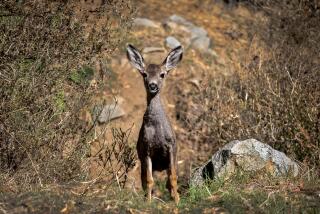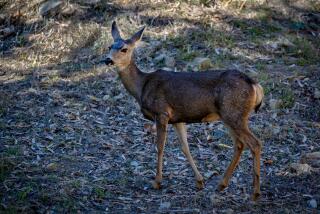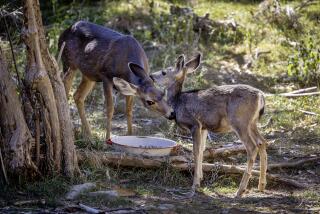WILDLIFE : Tiny Deer Stir Up Colossal Conflict on Florida Island : Some residents of Big Pine Key say preservation efforts are interfering with plans for a new elementary school.
- Share via
BIG PINE KEY, Fla. — About a million people a year drive through the refuge of one of this country’s most endangered species. But sometimes, the only Key deer they see is the one they hit with their car.
The body count is posted along U.S. Highway 1, on a sign with changeable numbers. Last year, 68 of the diminutive deer were found dead, 53 hit by vehicles. So far in 1994, the death toll stands at 22. Road kills account for 14.
But deer and motor vehicles are not the only things colliding here. Some of this island’s residents say the government’s efforts to protect the deer are infringing on their constitutional rights, especially when it comes to providing their children a good education.
At issue is a proposal to build an elementary school on the island, ending the need to bus Big Pine Key children to a school on neighboring Sugarloaf Key. Local environmentalists, as well as the U.S. Fish and Wildlife Service, oppose building a school, saying it will only spur more development.
“The fear we have is that the school is the foot in the door,” said Jon Andrew, manager of the Fish and Wildlife Service’s 8,000-acre Key deer refuge, which includes about half the area of Big Pine Key, largest of the Florida Keys.
“There were 800 people on Big Pine in 1970,” he said. “Now the population is 4,500. That has put a lot of pressure on the deer.”
The often-nasty fight over the school has been going on for five years. Swastikas and “kids before deer” graffiti have been spray-painted on highway signs.
“It’s really a bitter battle,” said Big Pine resident Debra Harrison, the Florida Keys coordinator for the Wilderness Society, which also opposes building a school. “I’ve been called a communist and an agent of Satan, and my son has been called a child of the devil.”
Proponents of the school say they are not anti-deer. “Nobody wants to see the extinction of a species,” said Shirley Mart Benson, a real estate agent and grandmother of school-age children. “But I believe in children first and deer second.”
The creature at the center of the brouhaha is a subspecies of the Virginia white-tailed deer that grows no bigger than a large dog.
As a result of hunting and habitat destruction, the Key deer nearly collided with extinction in the 1940s, when no more than 50 were believed to remain. But with the establishment of the federal refuge in 1957 and stepped-up law enforcement, the herd has been stabilized at about 300 deer.
The deer attract a lot of attention. “They are what I call a charismatic megafauna,” Andrew said. “Especially when you see a fawn, you want to pick it up. . . . People come here from all over the world to see them.”
Visitors and residents also feed them, a practice that can cause as many problems as speeding, Andrew said. “When every 10th person feeds them a slice of bread, they get tame. The deer concentrate in areas where they are being fed, and then if disease breaks out, it spreads quickly. People also leave, and the deer who have always been fed are milling around. We call them zombies.”
One particular incident involving the deer earlier this year earned wide notice. A doe, nicknamed Pine Needles, was released into the refuge after months of rehabilitation on two legs broken in a run-in with a car. But 10 days after being released with a radio collar, she was found dead.
Island resident Arthur K. Hilbert charges refuge managers with negligence in releasing the deer before it was able to fend for itself. He suggests fencing off an area of the refuge where injured animals could be monitored.
But assistant refuge manager Stuart Marcus defends the release of Pine Needles. “We knew it was risky. But our whole goal is to release deer back into wild, not to keep them as zoo animals.”
Meanwhile, Monroe County school board officials have proposed that an existing church building--outside the refuge area but on Big Pine--be used as a school and expanded as needed.
But Harrison, for one, remains stalwart in opposition.
“I live on Big Pine, and I have a 4-year-old, and I want the best education for my child,” she said. “But part of his education is being connected to wilderness and making certain sacrifices for endangered species.”
More to Read
Sign up for Essential California
The most important California stories and recommendations in your inbox every morning.
You may occasionally receive promotional content from the Los Angeles Times.













